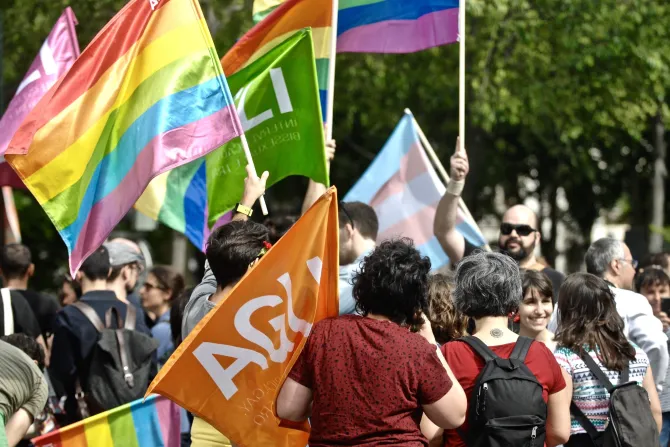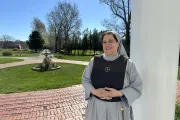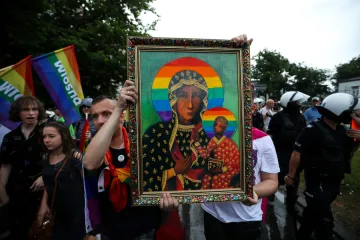John is not alone in seeking therapy to better understand the origins of same-sex attractions and to resolve past hurts.
“A guiding principle for all mental health professions is honoring the ‘self-determination’ of all clients,” said Sutton, who is also the founder and first director of the graduate counseling program at Franciscan University. “In my experience, those who engage in professional therapy to help persons manage and resolve same-sex attraction, honor their clients’ wish for this. If a client does not want to do this, the therapists whom I know and know of—and all ethical therapists—never force or compel a client to do so.”
The Catechism clearly articulates the Church’s teaching, said Sutton, that “persons with a homosexual inclination ‘must be accepted with respect, compassion, and sensitivity’”.
“This may include referring them for professional care,” Sutton said.
David saw a therapist for about six months to discuss his past relationships and life experiences. He also experiences same-sex attraction. He found great healing, he said, in being able to talk about personal experiences with a Catholic counselor who could integrate his faith into the conversation.
“To have counseling through a Catholic lens and to be able to see someone that respects my choice of how I’ve chosen to live in accord with the Church’s teachings with same-sex attraction, I find very helpful,” he said.
David pursued counseling to deepen his relationship with Christ as well as to navigate what it means to live with same-sex attraction as a practicing Catholic. In doing so, he developed a greater understanding of his desire to find purpose and love in his life, and to give himself in love within the context of the Church’s teaching, he said.
“As a person strives for virtue, including chastity, he or she needs to be aware of the experiences in his or her life that have shaped his or her sense of self, expectations, desires and thoughts,” said Father Bochanski. “When a person has experienced trauma, been hurt in family or other relationships, or is dealing with emotions or behaviors that he or she doesn't understand and can't control, it is often very helpful to seek the support and guidance of a professional trained in psychology and counseling.”
Michael Gasparro, registered associate marriage and family therapist, provides counseling from a Christian perspective to help people work through unwanted sexual behaviors, including sexual addiction, fetishism, sexual brokenness and sexual dysfunction in marital relations. He sees patients who are married, single, heterosexual and homosexual.
“We get hung up on same-sex sexuality sometimes and forget that a lot of people have wounds around sex and wounds around how to live that out that make it harder for them to live their vocation,” he said. “Therapy for many people is a place to talk about this without judgement and seek healing for the things that contribute to their sexual brokenness.”
For some patients, the process of working through past traumas and sexual chaos can result in a byproduct of reduced same-sex attraction, though that is not the goal of therapy, Gasparro said. The outcomes are up to the patient, with healing from previous experiences at the forefront of the discussion.
Austin originally went to a couple of counselors looking for advice on experiencing same-sex attraction and didn’t find what he was looking for. Then, he was referred to a therapist who focuses on reintegrative therapy.
“He explained to me that I was in the driver’s seat, I was in charge of setting the goals for what I wanted to get out of therapy,” he said. “He was clear in explaining that this was not a ‘conversion therapy,’ this was not to ‘fix me’ or supress my attractions.”
Instead, Austin engaged in a process of using therapeutic protocols based on empirical data to trace a fantasy or unwanted behavior, and tie it back to any kind of past unmet emotional need.
“I was desiring to be seen completely and known by other men, and that desire was eroticised and sexualised,” he said. “The goal of the therapy and the success was all about going back to that unmet need—that was the issue for me—not the attractions themselves … what needed fixing was the underlying roots behind them.”
Before Austin began therapy, he recognized that he had to desire healing for himself. It couldn’t come from his parents or anyone else wanting him to change his attractions.
“Having same-sex attraction is not immoral and it does not make you a bad person,” Austin said. “Acting on those desires in whatever way is going to be immoral. If someone is acting on these desires, this is one unique way they are falling to sin, and all of us fall to sin daily in different ways.”
One side effect of therapy for Austin was that his same-sex attractions did diminish, though not entirely. When they do surface, they do not distress him as much as they did in the past. He is able to see, he said, that he is not bad for having these attractions.
“I was able to see that I am desirable, and I do have men in my life who see and know me,” he said. “The attractions started to go away because I didn’t need to turn to sexual fantasy or behavior to fill that need that I was having.”
Scott (a pseudonym), who is 29 and works in ministry, is currently seeing a therapist to talk about life experiences in the present and life experiences in the past, including learning how to grieve past traumas appropriately. Rarely does the topic of homosexuality come up in his therapy sessions.
“The therapy that I’m undergoing right now is like any other therapy that anyone else would undergo,” he said. “It has nothing to do with ‘praying the gay away’ or other things you hear. It is not conversion therapy.”
Unfortunately, many types of therapy that address unwanted sexual behavior from a Christian or Catholic perspective get lumped together under the term “conversion therapy,” a broad and ill-defined term, said Gasparro. The term, in its common, secular understanding, refers to changing a person’s behavior from homosexual to heterosexual, and is the subject of legislation and a forthcoming documentary on Netflix.
“Many people care and they get angry surrounding the topic of conversion therapy because, maybe they’ve rightly heard stories of when it’s been harmful for someone, but they wrongly perceive that all therapies are conversion therapy,” Scott said.
He offered that there are harmful therapies out there from different groups, specifically in Evangelical Christian communities, where the focus is behavior modification and willing yourself to not have the attractions you are having. Scott also shared that it is important to remember that not all therapies—or therapists—are the same.
“Good therapy must have that same integration in mind, and treat the whole person as a unity of body and soul,” said Father Bochanski. “A good therapist will respect the client's whole story, rather than isolating just one part of the client's experience, whether sexual attraction or anything else.”
The push to change Catholic doctrine
When asked if the teachings of the Church need to be changed or adjusted to better accomodate people with same-sex attractions, the answer among interviewees was a consistent ‘no’.
“Nothing about Church teaching needs to be changed surrounding this topic, absolutely nothing,” said Santo. “I will say, what I think honestly needs to change is the way that these teachings are read. When I look at Church teachings with the knowledge that this Church, the Bride of Christ, loves me dearly and unreservedly, it all makes sense.”
Scott agreed about a deeper understanding and encounter with the Church’s teaching on human sexuality. He said he is “100 percent on board with the Church’s teaching on everything,” and that it is important the Church does not “bend to the outcry of one particular group.”
“I wouldn’t want to be part of a church that listens to the whim of society,” he said. “To bend to whatever philosophy is popular right now or that’s sort of a ‘hot topic’ is to contribute to one's own demise.”
In today’s society, attempts to change the teaching of the Church are presented regularly, as is the case in Tushnet’s article, which failed to interview a single, living Catholic theologian or therapist. This advocacy for change is typically influenced by a specific group that wants to change a teaching to conform to an ideology, instead of realigning their hearts to Christ.
“When clergy or others in ministry suggest that the teaching can change or should change, at best they are raising false hopes in the hearts of the faithful, and distracting them from seeking the support they need to understand and embrace the teaching and to live by it,” said Father Bochanski.
“This is a serious scandal and, as the Congregation for the Doctrine of the Faith explained in 1986, it ‘prevents homsexual men and women from receiving the help they need and deserve,’” he said.
Father Bochanski referred to this scandal as the oldest trick in the Bible.
“Consider the original sin—the serpent tempted the woman to lose trust in God's plan by distracting her attention from all the blessings that surrounded her in paradise, and getting her to focus on the one thing that she did not have,” Father Bochanski told CNA. “It is still the devil's agenda to shake our trust in God's plan and in the Church that teaches it, by putting our focus on what seem like restrictions and distorting our vision of what God actually provides for us.”
There is room for growth, however, in how the teachings are communicated and received, shared Austin.
“Practially, I would desire for priests to not just know the teachings, but to know the ‘why’ behind the desires, to have an understanding of why people experience same sex attraction,” he said.
David agreed that being comfortable with conversations in the Church, whether it be from Church leadership or the lay community, could be better. He emphasized that the Church is still learning the best ways to share teachings and to bring the teachings to others.
“One thing I’ve recognized is that sometimes well-intentioned people, poorly catechized, might not know the difference between living out same-sex attractions versus just experiencing them,” he said. “It’s not always well differentiated or taught.”
“People need to know that they have a place within the Church, and to know that they are welcome, their presence is desired, and they are loved and cared for,” he said.
Autumn Jones was a staff writer with Catholic News Agency through 2021. She is a graduate of Gonzaga University and the University of Colorado. She is based in Denver.







